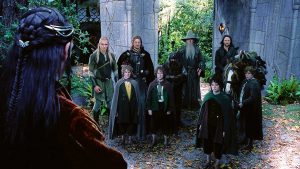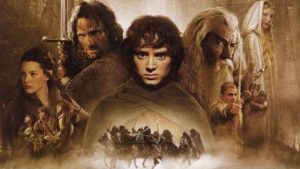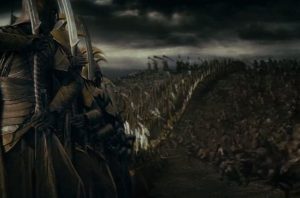MAJOR SPOILERS FOR THE RINGS OF POWER SEASON TWO, EPISODE ONE AHEAD!
Just as the first season of Amazon’s The Lord Of The Rings: The Rings Of Power opened with Morfydd Clark’s Galadriel narrating over a montage of scenes that followed her progression from a child of Valinorean peace and tranquility to a woman hardened by the ceaseless wars she and her kind brought to Middle-earth’s shores, season two tries to do the same for the character of Sauron and goes to show that Amazon hasn’t “bought” the Tolkien Estate (as some of the series’ detractors claim), seeing as they were evidently denied access to the descriptions of Sauron’s First Age activities found only in The Silmarillion and Unfinished Tales, resulting in a prologue and premiere episode that knows it would be so much stronger if it were free, either to adapt the source material or, barring that, outright contradict what it can’t adapt.

Until that time comes, The Rings Of Power will continue to dance on tip-toes – whether with the gracefulness of a fleet-footed Elf or a lumbering cave troll is entirely dependent on the individual writer for each episode – to avoid touching anything it legally cannot, including the most detailed account of Sauron’s origins (The Ainulindalë), his motivations (The Letters Of J.R.R. Tolkien and Morgoth’s Ring), and his deeds (The Silmarillion and Unfinished Tales), which significantly restricts The Rings Of Power‘s Sauron-centric prologue: from starting at a point in time even remotely equivalent to when Galadriel’s began; from using any of the names for Sauron that he canonically preferred to the one in common use among his enemies; from explaining that he belonged to a class of angelic beings called Maiar, specifically one tasked with maintaining order and coordination; from laying bare his vision, ultimately unobtainable save through the domination of all living things, of the world under his control; and from referring to how the Valar, the pantheon of godlike beings ranked above the Maiar in power and seniority, offered him a second chance after Morgoth’s defeat, which Sauron considered and rejected, being unwilling to part with the power he had obtained in Middle-earth.
Most of what was omitted can be inferred to exist still, offscreen. Sauron is not not a Maia in The Rings Of Power, the word just isn’t used. There are subtle hints in his dialogue that point to his true ideology and aims, maybe a bit too subtle, but they’re there. And for all we know, he could conceivably have had his moment of repentance shortly prior to when The Rings Of Power picks up his story as he gathers the Orcs at his fortress in cold Forodwaith, intending to be accepted as Morgoth’s successor. Jack Lowden’s Sauron is rather more pitiable than intimidating (and I can’t say that would be an entirely unfounded read of the villain), but his face befits the name Mairon, nowhere used in this sequence but plausibly still the name he wore as a Maia. The very best version of The Rings Of Power often isn’t the one onscreen, but the one hiding between-the-lines.

With that said, this episode is extremely entertaining in its own right, and again, we need only turn to the prologue – a very effective microcosm of the entire season so far – to understand why. It may be sacrilegious to suggest, but The Rings Of Power feels most at ease when it’s having fun playing in the vast sandbox that is Middle-earth, using the building-blocks at its disposal, but arranging them in ways that J.R.R. Tolkien wouldn’t have, like when it implied that Sauron and Galadriel had romantic feelings for each other, or when it invented an extremely compelling half-Elf, half-Orc character named Adar (Sam Hazeldine), whom Sauron inherited at the end of the First Age along with everything else that once belonged to Morgoth. Perhaps The Rings Of Power‘s single most valuable contribution to the Middle-earth legendarium is Adar, who not only straddles the line separating good and evil, but forces Middle-earth’s heroes and its villains alike to grapple with the disturbing implication that all Orcs straddle that line as much as any people – something that Tolkien himself was coming to acknowledge near the end of his life, but was never able to reconcile with his earlier depictions of the Orcs.
Adar’s decision, solidified in secret while Sauron addresses the Orcs and makes it increasingly clear that he not only doesn’t see them as his people but assumes it is in their nature to serve a Dark Lord (the same prejudice he accuses Elves and Men of holding), to kill Sauron then and there with his own crown, transforms a coronation into an execution, and all the Orcs get in a stab, until the bloodied heap that remains of Sauron erupts, sending shockwaves across Forodwaith. But while Adar and the Orcs depart in search of a new home, the camera tracks Sauron’s pooled blood as it runs in rivulets through cracks in the stone, coagulating deep underground into something utterly repulsive and somehow mesmerizing to watch, a mass of tiny feelers groping back towards the surface, absorbing small animals and insects; a sort of reverse-Gollum that gradually becomes more humanoid as it slithers purposefully out of the mountains, eventually getting stuck to the wheel of a merchant’s cart, consuming her, and thereafter wearing the body of Charlie Vickers’ Halbrand.

At this point (and through no fault of a consistently exceptional Vickers, I must add), the prologue gets bogged down contriving a string of unremarkable scenes intended to signal to the audience that Sauron’s pursuit of redemption under a new name throughout season one was not entirely a deception, as well as retroactively justifying how he came across the heraldry that allowed him to pass himself off as a lost king of the Southlands, and why we and Galadriel first encountered him on a raft in the middle of the Great Sea. The answers to these outstanding mysteries are linked, but neither is particularly interesting. It’s when Sauron returns to the Southlands in the body of the episode that Vickers gets to show off his strengths as an actor, an opportunity that season one deprived him of until its final few minutes. In his scenes opposite Adar (now the Lord of Mordor), Sauron, still disguised as Halbrand, manipulates masterfully – exposing the feigned weakness he wants Adar to believe he can wield as leverage over him, his concern for his people, and using that very same weakness on Adar’s part to begin amassing an army. There is such salt-of-the-earth sincerity in Sauron’s ruggedly handsome face and in his folksy accent that the absence of it in the half-smiles which crook the corners of his lips and never quite reach his steely eyes escapes notice initially.
If Vickers’ performance embodies the idea put forward in The Lord Of The Rings that the agents of evil “seem fair, and feel foul”, Hazeldine’s is the inverse: the grim set of his mouth and the slow, seemingly methodical way in which he moves do not betray emotion, but it roils under the surface and shimmers faintly far behind his eyes. Hazeldine is a less lanky man than Joseph Mawle, who played Adar in the first season, and his version of the character is physically imposing where Mawle’s was frail, without a trace of trembling rasp in his voice. But Adar’s love for the Orcs, the enveloping and unconditional love of a parent for their children, is as genuine coming from Hazeldine as it was from Mawle in season one, and both actors deliver the best performances of their respective seasons.
In comparison, the evolution of Morfydd Clark’s Galadriel and Robert Aramayo’s Elrond from one season to the next may not seem significant, but there is a newfound surety in their performances, with which comes the ability to turn over their characters and explore their different facets. Galadriel is still impulse-driven by nature, but she let those impulses drive her straight into a ditch in season one, forcing her to consult other emotions besides her shattered sense of self-righteousness as she tries to back out of her current predicament without accidentally entrenching herself any deeper. Elrond, by contrast, has never been more certain in his definition of “right” and “wrong”, and is aghast when High King Gil-galad (Benjamin Walker) doesn’t see it the same way, putting the idealistic young politician in an uncomfortable and isolating position where people he’s regarded his whole life as fundamentally good appear to be shedding their morals all around him.

Having Elrond grab the Three Rings and leap off a waterfall into the Gulf of Lhûn to prevent the Elves from using the devices of Sauron isn’t exactly subtle storytelling, but I respect The Rings Of Power for unapologetically foregoing subtlety in favor of spectacle every now and then. It’s the rare fantasy show in the post-Game Of Thrones television landscape that gets a kick out of testing its audiences’ suspension of disbelief. If we accept that Elves exist and can walk over snow without sinking and tell a person’s height and hair color from over fifteen miles away, why can’t they also survive a fall of many hundreds of feet into the ocean? What’s important is that Elrond isn’t just jumping off a waterfall for the sake of having something cool happen in an episode light on action, but because The Rings Of Power has exponentially raised the stakes by having Sauron involved in the forging of the Three Rings (a controversial deviation from the canonical account, where the Three are created behind Sauron’s back, after the Seven and the Nine) and deliberately obfuscating the extent of his involvement. It is a choice that the show proudly owns, taking advantage of the opportunity that’s emerged to closely and critically examine the Three Rings and the potential consequences of wearing them.
Enter the character of Círdan (Ben Daniels), the oldest and wisest Elf in all of Middle-earth, who harbors Elrond when he washes up in the Grey Havens and offers to discard the Three by dropping them into a submarine trench…only to have a change of heart and do the exact opposite of what he promised Elrond, putting on one of the Three himself and delivering the other two to Gil-galad and Galadriel. The Elves are able to slow their inevitable fading and continue the fight against Sauron in Middle-earth, but at the cost of becoming bound to the fate of the Three Rings (and therefore also Sauron, which, to be honest, does make a lot more sense if he had a hand in their creation). It may have been their best choice, but was it the right choice? The Rings Of Power leaves the audience with that question. Although, as a fan of Círdan, who has never had a speaking role in an adaptation of Tolkien’s works before, I’m also left wondering why the writers chose to utilize him in this way. Daniels is perfectly cast in the part, make no mistake, but the narrative does him no favors by having Círdan betray Elrond’s trust the way a parent might an errant child and then fall victim to the temptation of the Rings, all before most viewers will even have picked up his name.

I have no idea how to elegantly segue into talking about The Stranger (Daniel Weyman), still following the stars eastward into the land of Rhûn, where he believes he will learn, or relearn, his true name and purpose. Unfortunately, he’s no closer to finding any of those things after the first three episodes of season two, and spends almost the entirety of the premiere lost and going in circles, his genuinely charming banter with his stalwart Harfoot companion Elanor “Nori” Brandyfoot (Markella Kavenagh) the only highlight of this subplot. I’m not sure how much longer The Rings Of Power can even keep up the pretense that the Stranger’s identity is a mystery, when the magic staff that he keeps seeing in his dreams is referred to on several occasions not as a staff, or a stave, or even a wand, but a gand, derived from the Old Norse word gandr, one half of the name Gandálfr or, you guessed it, Gandalf (“wand elf”). There is no reason, none whatsoever, to use this particular word if the Stranger is not Gandalf. And if it’s a misdirect, I’ll be furious.
While the Stranger and Nori can certainly keep a conversation going, the return of Nori’s friend Poppy Proudfellow (Megan Richards) is a welcome relief at a particularly slow moment in this storyline, giving them both another person to bounce off. I’m inclined to believe, however, that her inclusion was the result of rewrites, because of how little effort is put into explaining why she decided to follow Nori after turning down the chance to travel with her and the Stranger last season or how she even caught up with them, and once added to the party, she does nothing that Nori could not also have accomplished. But I always wanted the three of them together anyway, so I can’t object to her reappearance, only to the fact that it doesn’t save this subplot, which continues to waste time in a season too short and too crowded already to spare even a second.

That’s the other big problem lingering over The Rings Of Power season two: the story it’s telling, spanning seven kingdoms and all the lands between, is simply too large to be condensed into a season of just eight episodes. Of course, it would help if every subplot was equally engaging, but regardless, there’s not enough time for them all to be fully fleshed-out. And the first episode is only juggling three, mind you, divided between Lindon, Mordor, and Rhûn – in the episodes that follow, The Rings Of Power makes its way around Middle-earth, revisiting Eregion, Khazad-dûm, Númenor, and the Southlands. Every location is its own enormous, fully-realized world, but the time we’ve spent in each is just barely enough to get reacquainted with the characters we already met last season. I’m not demanding twenty episodes, each an hour long, per season (though I wouldn’t object), but surely the most expensive show on television can afford ten?
Thankfully, The Rings Of Power is in no other aspect stingy. The first episode of season two boasts CGI more convincing than most blockbuster movies, breathtaking locations ranging from New Zealand to the Canary Islands, extensive practical sets, a panoply of props including the titular Rings, and gorgeous costumes (for more on that subject, see my interview with the series’ costume designer, Luca Mosca), of which my favorite is, perhaps surprisingly given its relative simplicity, the gray robe embroidered with golden waves that Círdan wears in his introductory scene: an unpretentious but beautiful garment well-fitted to its owner’s personality. Through the lens of director Charlotte Brändström (who directed the sixth and seventh episodes of season one) and cinematographer Alex Disenhof, Middle-earth bursts to life.

The flaws that have always held The Rings Of Power just a hair’s-breadth back from greatness continue to do so, but the series strains against its bonds and makes a valiant push forward in this episode, a reintroduction to the world and its characters that doesn’t seek anyone’s forgiveness for sizable changes to the source material, whether smart or baffling, but asks only for patience. If not all fans will be inclined to give it even that much, there are many still who will be intrigued by what the series is doing to grapple with the broader themes of Tolkien’s work, and I see enormous potential yet in this unconventional adaptation.
Episode Rating: 8/10



